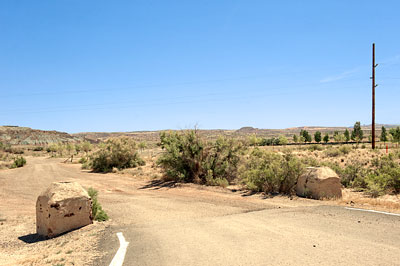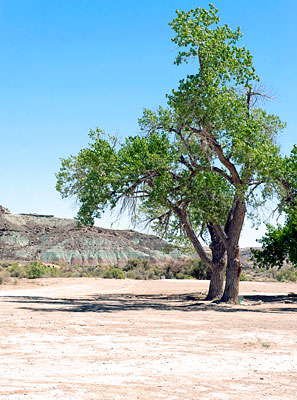National Register of Historic Places in Grand County
Dalton Wells Civilian Conservation Corps Camp and Moab Relocation Center
Highway 191
Approximately 13 Miles North of Moab
Dalton Wells had two distinct periods of historic significance.
During the 1930s, Dalton Wells Civilian Conservation Corps Camp exemplified the prevailing wisdom that the federal government was obligated to take an active role in the national economy during periods of national crisis.
From January 1943 to April 1943, the abandoned Dalton Wells CCC Camp was converted to the Moab Relocation Center for the incarceration of Japanese American citizens by the War Relocation Authority.
Internment centers such as those at Manzanar, Tule Lake, Gila and Topaz were bleak at best and little better than concentration camps. As the numbness and shock of forced relocation wore off, groups of internees, often led by those holding American citizenship, began to ask embarrassing questions, demand better treatment and point out corruption in the administration of the camps.
This resistance began at Manzanar in late 1942. The War Relocation Authority shipped sixteen of the Manzanar leaders to the abandoned camp at Dalton Wells. This first group arrived on January 11, 1943. Thirteen more from Gila arrived on February 18, followed six days later by ten more from Manzanar. The Tule Lake camp sent fifteen on April 2.
Conditions in Dalton Wells were worse than conditions in the regular camps. The inmates, all men, were denied permission to visit Moab, had their mail censored and were not allowed contact with their families.
At peak occupancy in late April 1943, the relocation center held forty-nine men.
In April, 1943, all Dalton Wells inmates were moved to an abandoned boarding school at Leupp, Arizona, then in December 1943, they were moved Tule Lake, California.
Adapted from the NRHP nomination submitted in 1994.

From an interpretive display at the site:
All that remains of the camp today are the cottonwood trees planted by the enrollees, concrete slabs for buildings, graveled roads and rock-outlined walkways, the remains of an old windmill, and a rock masonry water storage tank. These remnants signify the moving history of a time when America valiantly struggled to restore its economic stability and provide its young people with meaningful employment.
President Franklin Roosevelt came into office during the worst depression the nation had ever known. Fulfilling a campaign promise to put people to work, he instituted the New Deal to bring economic recovery to the depression-wrought country.
The National Industrial Recovery Act (NIRA) of 1933 authorized the Public Works Administration (PWA) to provide jobs, stimulate business activity, and increase purchasing power through the construction of permanent and socially useful public works. The Federal Government and local city, county and state governments formed a working partnership resulting in the greatest single construction program in history.
PWA construction projects, in addition to providing employment for the skilled, generated a volume of jobs for the unskilled. The PWA provided loans and grants up to forty percent of the total cost of the project to states, and many other public bodies, including schools.
From 1933-1935, the PWA underwrote projects in 3,040 of the 3,073 counties in all forty-eight states. Of the 3.76 billion dollars of
the NIRA fund, 2.56 billion dollars was spent on 19,004 construction projects.
Narrative adapted in part from the NRHP nomination for Tulare Union High School Auditorium and Administration Building
dated 16 November 1999.
Many buildings funded by the PWA have been recognized for their historic significance and architectural excellence. Among them are:
California
Adobe Chapel of the Immaculate Conception in San Diego
Aquatic Park in San Francisco
Beach Chalet Murals in San Francisco
Big Basin Redwood State Park Headquarters Building
Big Creek Bridge in Big Sur
Feather River Scenic Byway Tunnels
Federal Building in Merced
Federal Writers and Artists Projects in San Francisco
Gasquet Ranger Station
Mariposa County High School Auditorium
McClatchy Senior High School in Sacramento
Monterey County Courthouse in Salinas
Mountain View Adobe
Police Headquarters, Jail & Courts in San Diego
Rincon Annex Post Office in San Francisco
Sacramento Junior College
San Francisco State Teachers College
Sitka Main Post Office and Court House in Alaska
Sonora Youth Center
Stanislaus Forest Experiment Station
Sunshine School in San Francisco
The Fort in Taft
Theodore Judah School in Sacramento
Tulare Union High School
Nevada
Carson City Civic Auditorium
Hoover Dam
Southside School in Reno
Tonopah Main Post Office
USO Building in Hawthorne
Yerington Main Post Office
New Mexico
National Park Service Southwest Regional Office in Santa Fe
New Mexico School for the Deaf Building 2 in Santa Fe
New Mexico School for the Deaf Hospital in Santa Fe
New Mexico Supreme Court in Santa Fe
Oregon
Butte Falls Ranger Station in Butte Falls
Dead Indian Soda Springs Shelter in Rogue River National Forest
Fish Lake Shelter in Rogue River National Forest
Gold Beach Ranger Station
Lake of the Woods Ranger Station in Fremont-Winema National Forest
Lithia Park in Ashland
McKee Bridge Campground in Rogue River National Forest
Wrangle Gap Shelter in Rogue River National Forest
Utah
Bryce Canyon Airport
Dalton Wells Civilian Conservation Corps
Minersville City Hall
Rock House in Arches National Park

